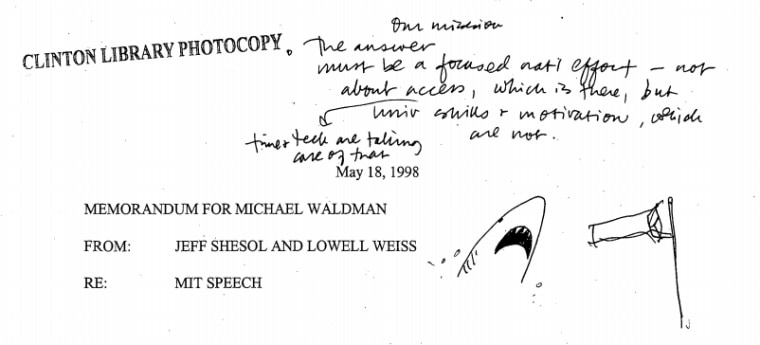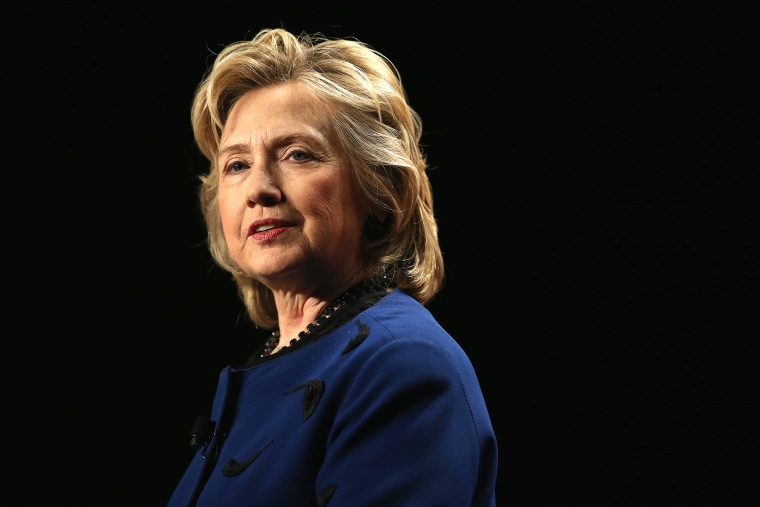Clintonologists received a veritable treasure trove on Friday, when the William J. Clinton Presidential Library website posted almost 4,000 pages of documents from President Clinton’s eight years in the White House. The documents were released under the Presidential Records Act, which made them eligible for publication once 12 years had transpired since the end of the Clinton presidency.
"When those restrictions expired, [the National Archives and Records Administration] then provided notification of our intent to disclose these presidential records to the representatives of President Obama and former President Clinton in accordance with Executive Order 13489, so that they may conduct a privilege review of the records," according to a statement from the National Archives. "As they complete their review, NARA is able to make the records available."
Journalists and political junkies immediately began combing through the documents for new information on the inner workings of the Clinton administration--particularly where it concerns then-first lady Hillary Clinton, now a rumored frontrunner for the Democratic presidential nomination in 2016.
Below are some of the initial revelations on how Hillary Clinton shaped her media strategy and her approach in selling health care reform to both Congress and the public.
1. “Hillary should own women’s media.” Ahead of then-first lady Hillary Clinton’s landmark speech at the 1995 U.N. Women’s Conference in Beijing, in which she declared that “human rights are women’s rights and women’s rights are human rights, once and for all,” aide Lisa Caputo outlined a media strategy to carry the message forward.
Among the suggestions: Booking the first primetime one-on-one interview with Dan Rather to “[establish] women’s issues as a serious story” and “help to reinforce our message that women’s issues are not ‘soft’ issues.” Caputo also suggested making “a special effort” toward Catholic women “should anything be ruffled.”
“Hillary should own women’s media,” Caputo writes, suggesting monthly meetings with the editors of women’s magazines. “Hopefully, this outreach will produce stories in the magazines about the President’s accomplishments and record and turn the editors into Clinton surrogates.” She suggests that the internet, which “has become a very popular mode of communication,” could form the foundation of a flattering People magazine piece.
“People magazine is tinkering with the possibility of using Internet,” she says about a pitch from the magazine for Clinton to talk about family issues with parents across the country. “They would then run the transcript in the magazine.”
The strategy memo also offers the first lady a three-sentence dossier on each of the eight reporters planning to travel with her to China and Mongolia. Some highlights:
• Terry Hunt of the Associated Press is “a fan of yours” and “an all-around good person.”
• Larry McQuillan of Reuters is “one of if not the nicest reporter in the White House Press Corps.”
• Andrea Mitchell of NBC is “very aggressive and a very good reporter.”
• Claire Shipman of CNN is “very fair and positive toward you” and “also very easy going.”
• Ann Compton of ABC “can be aggressive, but is usually very fair” and seems to have become “a Hillary fan on the [previous] South Asia trip.”
• Martha Teichner of CBS “is still talking about how wonderful the South Asia trip was.”
• Hillary Stout of the Wall Street Journal “covered [the Clinton’s failed effort to reform health care] and was one of the reporters who did the most balanced and most in-depth coverage of the debate.”
• Martha Brant of Newsweek Martha “is about 28 or 29 years old and has been a general assignment reporter with Newsweek for a year.”

The doodles pop up throughout the margins: a dog with a wagging tail, a carrott stick, and even a cartoon of a bald man with down-cast eyes.
3. Clinton thought the individual mandate would be a “much harder sell.” When she was trying to sell health care reform to congressional Democrats in 1993, Hillary Clinton expressed skepticism that the individual mandate could be politically viable as part of a final deal.
At the time, the Republican plan included an individual mandate, but later it became a central part of Obamacare. The policy, Clinton told a group of congressional Democrats, is “politically and substantively a much harder sell than the one we’ve got—a much harder sell.”
4. Some White House aides weren’t too sure about “if you like your plan, you can keep it” either. A 1994 memo from White House staffer Todd Stern raised concerns about the health care portion of the upcoming State of the Union Address.
“We have a line … that says ‘You’ll pick the health plan and the doctor of your choice.’ That sounds great and I know it’s just what people want to hear. But can we get away from it?” he wrote. “Isn’t the whole thrust of our health plan to steer people toward cheaper, HMO-style providers?”
Years later, President Obama would get hammered from the right for promising of Obamacare, “If you like your plan, you can keep it.”
5. 'Tool Time' with Hillary? Here's a '90s pop culture flashback. At the time, Home Improvement starring actor Tim Allen was one of the most popular shows on television. Staffers discussed the "wild idea" of the first lady appearing on the show as a guest -- something that just wasn't done at the time.
“I know this may sound like a wild idea, but I think it is an interesting one to discuss,” wrote the first lady’s press secretary, Lisa Caputo. "The outreach would be enormous and it would present Hillary in a very likeable light I believe."
Caputo added that though she had concerns the cameo "diminishes the role of first lady by going on a tv sitcom!" she said it was an option worth weighing.
6. 'Be real'
As HIllary Clinton was gearing up to enter politics herself, an aide advised her to adopt an informal and relaxed tone in her public appearances. "Don't be defensive. Look like you want the questions: The press is obviously watching to see if they can make you uncomfortable or testy. Even on the annoying questions, give relaxed answers," wrote Mandy Grunwald, an aide to Clinton, in a memo on July 6, 1999.
Grunwald's memo also included a suggestion for the first lady to "be careful to 'be real.'"
Geoff Cowley and David Taintor contributed reporting.
